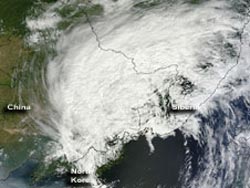NASA Satellite Sees Remnants of Tropical Storm Bolaven Racing Over China and Russia

NASA’s Terra satellite captured this natural-color image of Tropical Storm Bolaven on August 29 at 0220 UTC. Some clouds still remain over North Korea and extend over the Sea of Japan as Bolaven's remnants continue speeding to the north-northeast. Credit: NASA Goddard MODIS Rapid Response Team <br>
The Moderate Resolution Imaging Spectroradiometer (MODIS) on NASA’s Terra satellite captured this natural-color image of Tropical Storm Bolaven on August 29 at 0220 UTC.
Some clouds still remain over North Korea and extend over the Sea of Japan as Bolaven's remnants continue speeding to the north-northeast at 29 knots (33.3 mph/53.7 kmh).
The Joint Typhoon Warning Center issued the final bulletin on Bolaven on Aug. 28 at 2100 UTC (5 p.m. EDT/6 p.m. on Thursday, August 30, 2012 Asia/Pyongyang local time). Bolaven's maximum sustained winds at that time were near 35 knots (40 mph/65 kmh) and have weakened since.
It was centered about 350 nautical miles (402.8 miles/648.2 km) north of Seoul, South Korea near 41.6 North and 126.2 East.
According to Associated Press, Bolaven is responsible for the deaths of twelve people, eight of them fishermen. Bolaven left about 200,000 households in South Korea without power, but damages in North Korea are unknown. On Aug. 29, Bolaven's remnants were moving over eastern Siberia toward the Sea of Japan.
Text Credit: Rob Gutro
SSAI/ NASA's Goddard Space Flight Center, Greenbelt, Md.
Media Contact
All latest news from the category: Earth Sciences
Earth Sciences (also referred to as Geosciences), which deals with basic issues surrounding our planet, plays a vital role in the area of energy and raw materials supply.
Earth Sciences comprises subjects such as geology, geography, geological informatics, paleontology, mineralogy, petrography, crystallography, geophysics, geodesy, glaciology, cartography, photogrammetry, meteorology and seismology, early-warning systems, earthquake research and polar research.
Newest articles

A universal framework for spatial biology
SpatialData is a freely accessible tool to unify and integrate data from different omics technologies accounting for spatial information, which can provide holistic insights into health and disease. Biological processes…

How complex biological processes arise
A $20 million grant from the U.S. National Science Foundation (NSF) will support the establishment and operation of the National Synthesis Center for Emergence in the Molecular and Cellular Sciences (NCEMS) at…

Airborne single-photon lidar system achieves high-resolution 3D imaging
Compact, low-power system opens doors for photon-efficient drone and satellite-based environmental monitoring and mapping. Researchers have developed a compact and lightweight single-photon airborne lidar system that can acquire high-resolution 3D…





















